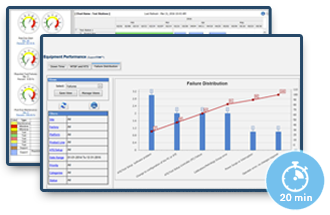

Asset Management Metrics are very important to success. I won’t say the most important though, because a number without a narrative that gives it meaning, relevance, and value might as well not exist. It won’t produce any change in direction or focus.
If you don’t have a purpose, by definition they aren’t complete
They are likely a complete waste of time in today’s fast-moving marketplace.
I recall a meeting over 15 years ago when a colleague of mine invited me to talk to his quality team. He was new to his role leading the team and I was excited for the opportunity to help my friend and to learn how the quality department of a highly successful Fortune 100 Aerospace & Defense firm operated.
We started the meeting by introducing ourselves. Their introduction included a list of metrics they used for “audit purposes”. I asked about two metrics to understand what they were used for. “Don’t know.” Who uses them? “Somebody must.” When did you start measuring them? “We’ve always done our metrics like this.”
These types of answers are the result of the previous industrial revolution. People acting as a “cog” in the larger organizational wheel. They really didn’t need to understand much outside of the standard work required to do their job. Anything more was a distraction and reduced efficiency. They produced reports. Someone else did something with them…or at least at some point, they did.
Metrics are Enablers for Outcomes
They help us know if we are on track or if we need to adjust our actions. They tell us if our team is on track or if they need help. They can help to measure cultural behaviors and, made visible and combined with targeted narratives, enable us to change ineffective behaviors.
We use three categories of metrics. I’ve included some examples of our metrics in each of these categories.
- Operational Metrics: measuring the performance and trustworthiness of processes and their outcomes
- Responsiveness
- Proactiveness
- Practice Accountability
- On-time
- Past Due
- Accuracy
- Downtime
- Proactive versus Reactive Behaviors
- Utilization
- Satisfaction
- Technology Metrics: measuring the trustworthiness of technology
- Obsolescence
- Standardization
- MTBF
- Financial Metrics: measuring income statement and balance sheet impacts
- Capital Avoidance / Capacity
- OPEX Avoidance
- Disposition
- Services Savings
- NET Cash Flow
Baseline and Then Act to Produce Outcomes
When we start any engagement we begin by helping our customers baseline their current performance. Often they don’t have practices in place to drive the outcomes we ultimately help them to produce, so we are mostly focused on the outcomes that are already known, like spending, as well as those we can audit to determine, like utilization. It turns out utilization is often an indicator of whether spending is higher than it needs to be and if we can anticipate bottlenecks caused by equipment availability that results in process delays.
With a very small set of metrics, we can define the size of the improvement opportunity. Capitalizing on the opportunity requires the full set of metrics customized to the specific situation your company or department is in.
Stay Grounded in the Value of What you are Measuring
Be clear that the metrics you use, and the narratives you use them with, are producing the intended results. Make sure they measure important leading indicators of success so you know where you need to focus to get back on track if the program drifts.
Use Metrics with Compelling Narratives to Produce Behavioral Change
Just as existing perverse incentives drive undesirable behaviors and habits (like hoarding) so effective metrics and narratives will produce a virtuous cycle that accelerates the adoption of effective behaviors (like trust-building, truth-telling, collaboration, and invention).
Sente’s Culture Change Algorithm Works in Tandem with Our Asset Management Software and Metrics
We help our customers execute our proven culture/behavior change algorithm as part of, and support by, our software implementation. Read more about this in, “Are Your Teams Designed For Speed, Quality & Effectiveness? We Accelerate Results With our Culture Change Algorithm.”
Request a Demo

See how Scireo aEAM Software drops asset and support costs by 50% while accelerating time-to-market 2X.
Relevant Content
Case Study: Aerospace Company Drives One Company Synergies
Like many aerospace companies, this one had many sites and different legacy cultures on each. See how they installed common resource management tools, increased utilization 3X and funded new programs.
Equipment Utilization Case Study: Space Company Leverages Assets
The hoarding culture was slowing this company down while impacting cost and quality. See how a journey to common processes and collaboration lead to a 50% reduction in assets as their business doubled.
Are Your Teams Equipped For Speed? Accelerate With aEAM Algorithms.
We are in a new age of competition that the World Economic Forum calls the 4th Industrial Revolution. New tools and technologies are enabling people to fulfill new and more competitive intentions ramping competitive pressures on everyone to move with speed and efficiency or risk failure. Incremental changes won’t work. They simply won’t be enough…
Equipment Utilization: What’s your number?
Measuring equipment utilization is the best way I know to determine if your assets are being hoarded and, as a result, if your business is incurring all of the costs associated with it. Hoarding creates the need to acquire equipment that’s not really needed and all of the support costs as well. It also causes…
Customer-Focused Maintenance Teams Accelerate Revenues & Time-to-Market.
Do Yours?
Why are Maintenance Teams so Important? Because they are responsible for keeping plant and equipment up and running so that orders from customers can be quickly produced, shipped, billed and converted to cash. Any breakdown in production inevitably leads to shipping delays, dissatisfied customers, slowed payments, reduced profitability, delays to cash and reductions in stock…
Asset Management Success Factors: It’s the Humans, Stupid!
We don’t organize merely around managing assets. Assets are easy to manage. They never have a bad day. They are never dissatisfied with their work, ask for more money, have hidden agendas or storm out of the room — although over the years we have heard quite a bit about how assets “walked”. Assets can’t…
Notable Quotes
“We wanted to understand Sente’s Total Cost of Ownership model – which was very detailed – and make sure the cost savings were real. Our own analysis confirmed that TRM would save us money. But at the end of the day, we moved forward because of the increased capacity the solution would provide to our engineering organization.”
Director of Finance










